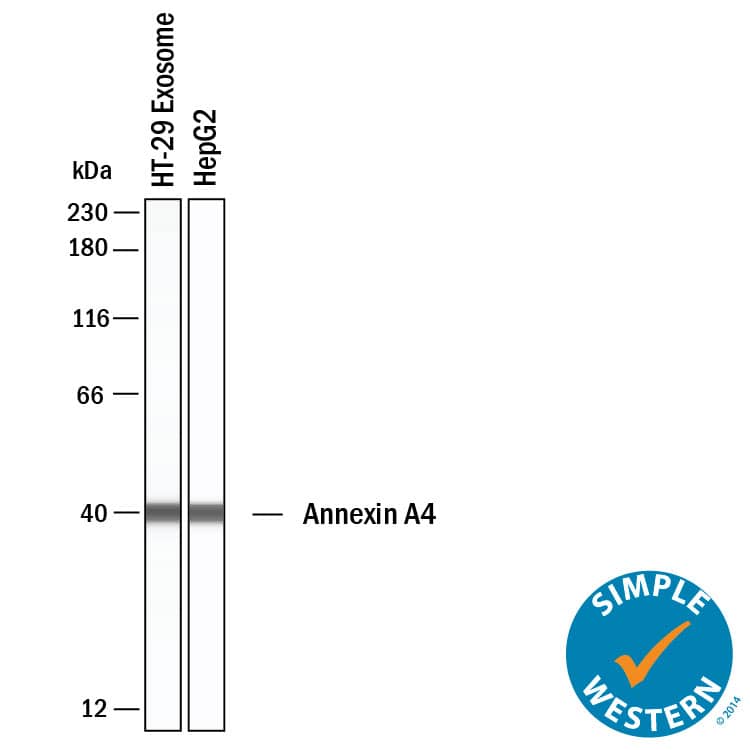Human/Mouse/Rat Annexin A4 Antibody Summary
Met1-Asp321
Accession # NP_001144
*Small pack size (-SP) is supplied either lyophilized or as a 0.2 µm filtered solution in PBS.
Applications
Please Note: Optimal dilutions should be determined by each laboratory for each application. General Protocols are available in the Technical Information section on our website.
Scientific Data
 View Larger
View Larger
Detection of Human/Mouse/Rat Annexin A4 by Western Blot. Western blot shows lysates of HepG2 human hepatocellular carcinoma cell line, NIH-3T3 mouse embryonic fibroblast cell line, and Rat-2 rat embryonic fibroblast cell line. PVDF membrane was probed with 1 µg/mL of Human/Mouse/Rat Annexin A4 Antigen Affinity-purified Polyclonal Antibody (Catalog # AF4146) followed by HRP-conjugated Anti-Goat IgG Secondary Antibody (Catalog # HAF017). A specific band was detected for Annexin A4 at approximately 36 kDa (as indicated). This experiment was conducted under reducing conditions and using Immunoblot Buffer Group 2.
 View Larger
View Larger
Detection of Human Annexin A4 by Simple WesternTM. Simple Western shows lysates of Exosome Standards (HT‑29) (NBP3-11685) and HepG2 human hepatocellular carcinoma cell line, loaded at 0.5 mg/ml. A specific band was detected for Annexin A4 at approximately 40 kDa (as indicated) using 20 µg/mL of Goat Anti-Human/Mouse/Rat Annexin A4 Antigen Affinity-purified Polyclonal Antibody (Catalog # AF4146). This experiment was conducted under reducing conditions and using the 12-230kDa separation system.
 View Larger
View Larger
Annexin A4 in Human Kidney. Annexin A4 was detected in immersion fixed paraffin-embedded sections of human kidney using Human/Mouse/Rat Annexin A4 Antigen Affinity-purified Polyclonal Antibody (Catalog # AF4146) at 10 µg/mL overnight at 4 °C. Before incubation with the primary antibody, tissue was subjected to heat-induced epitope retrieval using Antigen Retrieval Reagent-Basic (Catalog # CTS013). Tissue was stained using the Anti-Goat HRP-DAB Cell & Tissue Staining Kit (brown; Catalog # CTS008) and counterstained with hematoxylin (blue). Specific staining was localized to plasma membranes, cytoplasm and nuclei. View our protocol for Chromogenic IHC Staining of Paraffin-embedded Tissue Sections.
Reconstitution Calculator
Preparation and Storage
- 12 months from date of receipt, -20 to -70 °C as supplied.
- 1 month, 2 to 8 °C under sterile conditions after reconstitution.
- 6 months, -20 to -70 °C under sterile conditions after reconstitution.
Background: Annexin A4
Annexin A4 (ANXA4), also known as Lipocortin IV, placental anticoagulant protein II and zymogen granule membrane-associated protein, 36 kDa (ZAP36), is a 321 amino acid, 36 kDa member of the Annexin protein family. Annexins are a family of Calcium-dependent phospholipid-binding proteins that are preferentially located on the cytosolic face of the plasma membrane. The Annexin’s have a molecular weight of approximately 35 to 40 kDa and consist of a unique amino terminal domain followed by a homologous C-terminal core domain containing the calcium-dependent phospholipid-binding sites. The C terminal domain is comprised of four 60‑70 amino acid repeats, known as annexin repeats or an endonexin fold (Annexin A6 contains 8 annexin repeats). The four annexin repeats form a highly alpha -helical, tightly packed disc known as the annexin domain, which binds to phospholipids in the membrane in a calcium-dependent manner. Members of the annexin family play a role in cytoskeletal interactions, phospholipase inhibition, regulation of cellular growth, and intracellular signal transduction pathways. Human Annexin A4 shares 92% identity with mouse and rat Annexin A4.
Product Datasheets
Citations for Human/Mouse/Rat Annexin A4 Antibody
R&D Systems personnel manually curate a database that contains references using R&D Systems products. The data collected includes not only links to publications in PubMed, but also provides information about sample types, species, and experimental conditions.
7
Citations: Showing 1 - 7
Filter your results:
Filter by:
-
Notch1 is required to maintain supporting cell identity and vestibular function during maturation of the mammalian balance organs
Authors: Heffer, A;Lee, C;Holt, JC;Kiernan, AE;
bioRxiv : the preprint server for biology
Species: Mouse
Sample Types: Whole Tissue
Applications: Immunohistochemistry -
Annexin A4 Is Dispensable for Hair Cell Development and Function
Authors: Nana Li, Yuehui Xi, Haibo Du, Hao Zhou, Zhigang Xu
Frontiers in Cell and Developmental Biology
Species: Mouse
Sample Types: Whole Tissue
Applications: Immunohistochemistry -
Fgf8 genetic labeling reveals the early specification of vestibular hair cell type in mouse utricle
Authors: Evan M. Ratzan, Anne M. Moon, Michael R. Deans
Development
-
Atoh1 Directs Regeneration and Functional Recovery of the Mature Mouse Vestibular System
Authors: ZN Sayyid, T Wang, L Chen, SM Jones, AG Cheng
Cell Rep, 2019-07-09;28(2):312-324.e4.
Species: Mouse
Sample Types: Whole Tissue
Applications: IHC -
Transcription factor induced conversion of human fibroblasts towards the hair cell lineage
Authors: MB Duran Alon, I Lopez Hern, MA de la Fuen, J Garcia-San, F Giraldez, T Schimmang
PLoS ONE, 2018-07-06;13(7):e0200210.
Species: Human
Sample Types: Whole Cells
Applications: ICC -
Functional development of mechanosensitive hair cells in stem cell-derived organoids parallels native vestibular hair cells
Nat Commun, 2016-05-24;7(0):11508.
Species: Mouse
Sample Types: Whole Cells
Applications: IHC-Fr -
Single-cell RNA-Seq resolves cellular complexity in sensory organs from the neonatal inner ear.
Authors: Burns JC, Kelly MC, Hoa M et al.
Nat Commun
FAQs
No product specific FAQs exist for this product, however you may
View all Antibody FAQsReviews for Human/Mouse/Rat Annexin A4 Antibody
There are currently no reviews for this product. Be the first to review Human/Mouse/Rat Annexin A4 Antibody and earn rewards!
Have you used Human/Mouse/Rat Annexin A4 Antibody?
Submit a review and receive an Amazon gift card.
$25/€18/£15/$25CAN/¥75 Yuan/¥2500 Yen for a review with an image
$10/€7/£6/$10 CAD/¥70 Yuan/¥1110 Yen for a review without an image
